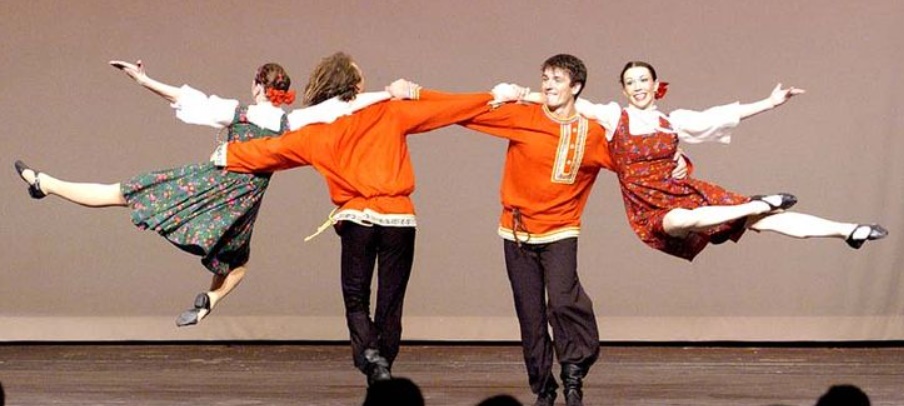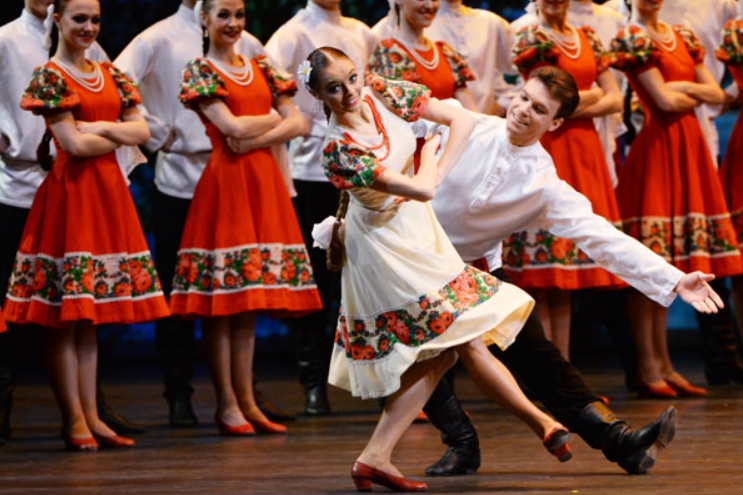Russia is a nation of great diversity, and Russian folk dances are one of the factors reflecting this aspect very well.
Other than the Eastern Slavic style that is quite well-known to foreigners, I have also selected other dances created by natives with a slight influence from nearby countries.
Let’s see how broad the range is!
Table of Contents
9 Popular Russian Folk Dances
1. Barynya
For Russian people, Barynya seems to have been around forever. The name means “landlady” – a respectful way commoners refer to elite women. However, the routine of the dance might surprise you a bit!
In Barynya, there is no specific move you have to learn by heart. The dancers simply string traditional squatting and spirited stomping together for a choreography performed to the music of Garmon and Balalaika.
The chastuskas (short and humorous folk poems) for Barynya used to include the “Barynya, barynya, sudarynya-barynya” refrain. These poems might carry a sprinkle of sensuality, too.
You might find various Russian dance ensembles with the same name, as well as more refined and developed versions!
Check more: List Of 8 Traditional American Dances
2. Beryozka

Originally named Berezka and more affectionately known as Beryozka, the dance is about “a little white birch tree”. It was created by the alumna of the Bolshoi Ballet, Nadezhda Nadezhdina.
Nadezhdina insisted that Beryozka came from the creativity of people, but she composed it and thus it wasn’t a folk dance.
However, experts recognized a great number of elements from Khorovod, a folk dance ritual that has been existing for a millennium.
In Russian culture, the birch tree symbolizes renewal, even the goddess worshiped using it was also believed to be the primogenitor of all lives, hence Beryozka was always performed at the beginning of spring.
The all-female dance team will adorn the traditional sarafans but beneath these long, flowy dresses, the footwork is truly impressive and powerful enough to make the ladies appear afloat and graceful.
3. Kalinka
If you ask around, many people will tell you that Kalinka is an iconic traditional Russian dance. The birth of Kalinka is synchronized with the popular, albeit simple song with the same name, and it means “a snowball berry” in English.
Kalinka’s steps vary but are overall agile with knee bends and high jumps, hence the dancers usually stick to low heels, so their movements won’t be hindered. The rest of the outfit follows the tradition quite closely.
The significance of Kalinka is irreplaceable in Russian culture, even though it is not a daily practice. Its international popularity was shown in the excitement it brought to the 2008 So You Think You Can Dance.
4. Kamarinskaya
Although the Kamarinskaya we mostly know today is the composition of Mikhail Glinka, it was entirely based on a folk song and its accompaniment dance. Hence, one could say it was the opposite of Kalinka’s case.
The traditional Kamarinskaya is known as a fast-paced dance with triple-bar phrase lengths as its distinctive feature. The most associated dance move with it is the Kazatsky squat.
Kamarinskaya became the first folk song that was turned into an orchestral work. The piece includes a second bridal theme with a transition, though the ending tune and dance remain Kamarinskaya.
5. Khorovod
Known as Horovod too, Khorovod is an East Slavic art form that has existed for over a millennium, which makes it one of the oldest Russian dances that we still have access to.
The sign for you to recognize Khorovod is the dancers holding hands or little fingers while moving in a circular formation. It is a ritual carried out around the sun, symbolizing friendship and unity.
Khorovod has several versions across the territory of Old Russia.
For example, northern people prioritize subtlety and gentleness, but central regions keep it lighthearted and joyful, and southern dancers showcase limitless energy with challenging steps.
6. Kozachok
Kozachok has Ukrainian origin, originating in the 16th century along with the Cossacks. It was a fast folk dance weaving its way into noble courts in Russia, France, Poland, and more. However, it remains a duo dance.
The most noticeable detail about Kozachok is that the female will be the lead and the male will be the follower.
The Russian Kozachok has other versions, such as the Terek Kazachok (north Caucasus) and Kuban Kazachok (Krasnodar), likely because the Ukrainian population was domineering in these regions.
In modern times, we have the Kozachok Podilskyi courtship dance created by the prestigious choreographer Vasyl Avramenko. Dance experts consider it a combination of theater pieces he has done and dance repertoires of multiple generations.
7. Pereplyas
In its early days, Peraplyas was accompanied by folk songs but performed by soldiers. The practice was described as a virtue competition of agility, strength, endurance, and cleverness as the dancers improvised with their moves most of the time.
The competition can be male vs. female, male vs. male, or female vs. female.
The initiator will perform a set of moves and the opponent will have to repeat all of them before showcasing another series of steps. Consequently, each turn will include more and more difficult challenges.
In another setting, instead of repeating the opponent’s moves, you will have to come up with a response without using their moves at all, and whoever runs out of creativity first will lose!
A hardcore version of Pereplyas only requires the contestants to dance until one of them is too drained to continue! People see it as a fun way to practice and improve their stamina.
8. Troika
Troika is more acknowledged as a dance for stage performance, though it has a folk origin as well. The name means “a three-horse gear”, hence dancers will mimic horses pulling a carriage or a sled.
The Troika choreography we know now has the same creator as the Beroyzka. From an addition to the troupe, it became a welcomed part of the repertoires of all Russian ensembles, especially the ethnographic ones.
At first, the trio included one man and two women, yet it is no longer a mandatory detail in later versions of the dance!
9. Trepak
Usually referred to as Tropak, Trepak is a folk dance with both Russian and Ukrainian origins. It is sometimes confused with Hopak, but the use of chords and the tempo are quite different on both sides.
The best-known representative of Trepak is the routine included in Tchaikovsky’s The Nutcracker, in both music and choreography aspects.
The entire choreography of Trepak, unfortunately, didn’t survive and thrive in our time, except for its plain walk and stamp that is typically performed to a quickened rhythm.
You can find an example of it in Season 4 – Week 9 of So You Think You Can Dance, where Stephen Boss and Joshua Allen danced to Trepak.
Conclusion
How many of these Russian folk dances have you had the pleasure of having in your dance library? Do you have a particular favorite that you have even practiced?
I would love to have your contribution and share to complete my list further because a short compilation could never cover the whole dance culture of a country!


